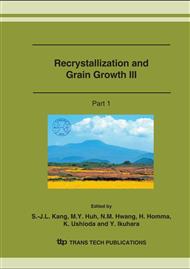p.313
p.319
p.323
p.329
p.333
p.339
p.345
p.351
p.357
On the Recrystallisation Characteristics and Kinetics of a 9SMn28 Free Cutting Steel
Abstract:
The static and metadynamic recrystallisation characteristics of a 9SMn28 (EN 1.0715) free cutting steel have been evaluated by employing the stress relaxation technique. In the steel, the sulphur was bound in the form of numerous MnS inclusions. Fractional softening laws stating the kinetics of static and metadynamic softening behaviour were experimentally determined and compared with the existing literature data for C/C-Mn steels. The analysis of the static recrystallisation data suggested the powers of the strain and strain rate to be -2.7 and -0.13, respectively, and the apparent activation energy was estimated as 177 kJ/mol. The power of grain size was taken from a regression model developed previously that is able to predict the static recrystallisation kinetics of vast number of carbon and microalloyed steel grades. Even though a fraction of Mn was out of the solid solution in the form of sulphides, the predictions by the regression model as accounting the balance Mn in the solid solution were quite close to the experimental data, confirming the applicability of the model. As expected, the metadynamic recrystallisation behaviour showed a strong dependence on the strain rate, the power being -0.78 and the apparent activation energy 57 kJ/mol.
Info:
Periodical:
Pages:
333-338
Citation:
Online since:
October 2007
Price:
Сopyright:
© 2007 Trans Tech Publications Ltd. All Rights Reserved
Share:
Citation:


